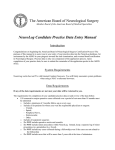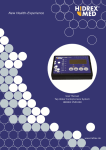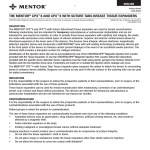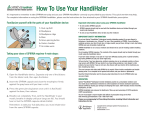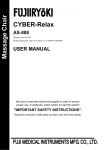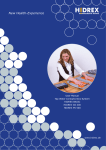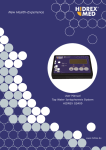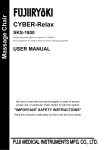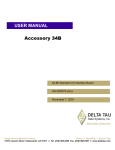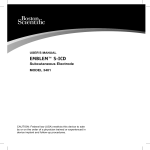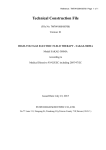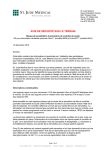Download Style 133V Series Tissue Expander Matrix
Transcript
Directions for Use Directions for Use Style 133V Series Tissue Expander Matrix MAGNA-SITE INJECTION SITES WITH ® CAUTION: U.S. Federal law restricts this device to sale by or on the order of a licensed physician. TABLE OF CONTENTS Section Page Styles Included . . . . . . . . . . . . . . . . . . . . . . . . . . . . . . . . . . . . . . . . . . . . . . .2 Description . . . . . . . . . . . . . . . . . . . . . . . . . . . . . . . . . . . . . . . . . . . . . . . . . .3 Indications . . . . . . . . . . . . . . . . . . . . . . . . . . . . . . . . . . . . . . . . . . . . . . . . . .4 Contraindications . . . . . . . . . . . . . . . . . . . . . . . . . . . . . . . . . . . . . . . . . . . . .5 Information That Should Be Provided to the Patient . . . . . . . . . . . . . . . . . . .5 Warnings . . . . . . . . . . . . . . . . . . . . . . . . . . . . . . . . . . . . . . . . . . . . . . . . . . .6 Precautions . . . . . . . . . . . . . . . . . . . . . . . . . . . . . . . . . . . . . . . . . . . . . . . . .8 Adverse Reactions . . . . . . . . . . . . . . . . . . . . . . . . . . . . . . . . . . . . . . . . . . .10 Research on Silicone Implants . . . . . . . . . . . . . . . . . . . . . . . . . . . . . . . . . .13 Instructions for Use . . . . . . . . . . . . . . . . . . . . . . . . . . . . . . . . . . . . . . . . . .15 Surgical Procedure . . . . . . . . . . . . . . . . . . . . . . . . . . . . . . . . . . . . . . . . .15 Single Use . . . . . . . . . . . . . . . . . . . . . . . . . . . . . . . . . . . . . . . . . . . . . . . .15 Product Identification . . . . . . . . . . . . . . . . . . . . . . . . . . . . . . . . . . . . . . .15 Sterile Product . . . . . . . . . . . . . . . . . . . . . . . . . . . . . . . . . . . . . . . . . . . .15 Product Accessories . . . . . . . . . . . . . . . . . . . . . . . . . . . . . . . . . . . . . . . .16 How to Open Product Package . . . . . . . . . . . . . . . . . . . . . . . . . . . . . . . .16 Preliminary Product Examination . . . . . . . . . . . . . . . . . . . . . . . . . . . . . .16 Techniques for Using Breast Tissue Expanders . . . . . . . . . . . . . . . . . . .17 MAGNA-FINDER® Cleaning and Resterilization Instructions . . . . . . . . . . .21 Reporting and Return of Explanted Devices . . . . . . . . . . . . . . . . . . . . . . . .23 Returned Goods Policy . . . . . . . . . . . . . . . . . . . . . . . . . . . . . . . . . . . . . . . .23 Limited Warranty, Limitation of Liability and Disclaimer . . . . . . . . . . . . . . .23 Product Ordering . . . . . . . . . . . . . . . . . . . . . . . . . . . . . . . . . . . . . . . . . . . .23 Page 1 STYLES INCLUDED STYLE 133 FV Shaped Tissue Expander Full Height, Variable Projection Saline-Filled BIOCELL® Textured MAGNA-SITE® Injection Site STYLE 133 MV Shaped Tissue Expander Moderate Height, Variable Projection Saline-Filled BIOCELL® Textured MAGNA-SITE® Injection Site STYLE 133 SV Shaped Tissue Expander Short Height, Variable Projection Saline-Filled BIOCELL® Textured MAGNA-SITE® Injection Site STYLE 133 LV Shaped Tissue Expander Low Height, Variable Projection Saline-Filled BIOCELL® Textured MAGNA-SITE® Injection Site Page 2 DESCRIPTION The Allergan Style 133V Series Tissue Expander Matrix is intended for temporary subcutaneous implantation and requires periodic, incremental inflation with sterile saline for injection until the desired amount of tissue is developed. Allergan’s Style 133V Series Tissue Expanders are constructed from silicone elastomer and consist of an expansion envelope with a BIOCELL® textured surface, and a MAGNA-SITE® integrated injection site. The expanders are available in a wide range of styles and sizes to meet diverse surgical needs. Specific styles are described above, under Styles Included. All Allergan Style 133V Series Tissue Expanders with the MAGNA-SITE® integrated injection port are supplied with a sterile MAGNA-FINDER® external locating device. In addition, Tissue Expander Fill Kits, BIOCELL® Delivery Assistance Sleeves and other product accessories are available separately. For more information on specific styles and accessories, please contact your Allergan Breast Aesthetics Business Development Manager, or the Customer Care Department at 1.800.766.0171. Breast Tissue Expander Shapes • Allergan’s Style 133V Series Tissue Expanders are designed as part of a system for breast reconstruction to create a pocket for placement of a NATRELLE™ breast implant. Shell Characteristics BIOCELL® textured surface is designed to promote mild tissue adherence and breast tissue expander immobility. • Stable bases for greater control over expansion direction are available on all styles. • Page 3 DESCRIPTION (cont’d) Injection Sites The MAGNA-SITE® injection site and MAGNA-FINDER® external locating device contain rare-earth, permanent magnets for an accurate injection system. When the MAGNA-FINDER® external locating device is passed over the surface of the tissue being expanded as described in INSTRUCTIONS FOR USE, its rare-earth, permanent magnet indicates the location of the MAGNA-SITE® injection site. • All injection sites contain a self-sealing port and a titanium needle guard (see Figure 1) to prevent inadvertent puncture through the base of the injection site. • Figure 1: MAGNA-SITE® & MAGNA-FINDER® Locating System NOTE: In vitro tests show that the MAGNA-SITE® injection site is detectable through 60 mm of phantom tissue. CAUTION: DO NOT use MAGNA-SITE® breast tissue expanders in patients who already have implanted devices that would be affected by a magnetic field (e.g., pacemakers, drug infusion devices, artificial sensing devices). DO NOT perform diagnostic testing with Magnetic Resonance Imaging (MRI) in patients with MAGNA-SITE ® breast tissue expanders in place. See Magnetic Field under WARNINGS for more information. THE INDICA TIONS AND CONTRAINDICATIONS BELOW ARE GENERALIZED. EACH PATIENT MUST BE INDIVIDUALLY EVALUATED FOR TISSUE EXPANSION BASED ON THE MEDICAL JUDGMENT OF A QUALIFIED SURGEON. INDICATIONS Breast reconstruction following mastectomy. • Treatment of underdeveloped breasts. • Treatment of soft tissue deformities. • Page 4 CONTRAINDICATIONS MAGNA-SITE® breast tissue expanders should not be used in patients who already have implanted devices that would be affected by a magnetic field (e.g., pacemakers, drug infusion devices, artificial sensing devices). • Tissue at the intended expansion site determined unsuitable by the surgeon. To a varying degree, radiation damage, ulceration, compromised vascularity, history of compromised wound healing, or scar deformity may affect tissue suitability. • Active infection at the expansion site. • Residual gross tumor at the intended expansion site may significantly complicate the expansion process and local tumor treatment. • Adjuvant radiation therapy is a relative contraindication and may make use of the breast tissue expander more difficult and increase the risk of complications. • Physiological condition determined by the surgeon to pose unduly high risk of surgical and/or postoperative complications. To a varying degree, sensitive over or underlying anatomy, obesity, smoking, diabetes, autoimmune disease, hypertension, chronic lung or severe cardiovascular disease, or osteogenesis imperfecta may affect patient suitability for breast tissue expander surgery. • Use of drugs that might result in high surgical risk and/or significant postoperative complications, including any drug that would interfere with blood clotting or affect tissue viability. • Psychologically unsuitable patient. • INFORMATION THAT SHOULD BE PROVIDED TO THE PATIENT While tissue expansion may be a beneficial surgical alternative for many patients, it may not be appropriate for every patient, because it is a time and labor intensive process that may cause temporary discomfort and distortion. The surgeon is responsible for selecting appropriate candidates, and counseling those patients on the risk/benefit relationship. Before breast tissue expander placement, patients should fully understand the elective nature of the procedure, and be willing to comply with expansion process requirements to minimize the risk of complications. Warnings, Precautions, Adverse Reactions Allergan relies on the surgeon to advise the patient of all warnings, precautions, and adverse reactions before the decision to proceed with breast tissue expander placement and inflation. The surgeon should advise the patient that adverse reactions may interfere with the original surgical plan and that medical management may include premature explantation. Page 5 INFORMATION THAT SHOULD BE PROVIDED TO THE PATIENT (cont’d) Informed Consent: Information for Patients Form The Allergan Style 133V Tissue Expander Informed Consent: Information for Patients form may be used to facilitate patient awareness and acceptance of the risks associated with silicone breast tissue expander surgery. The two-part form allows both the patient and the surgeon to retain copies for their records. Please contact your Allergan Breast Aesthetics Business Development Manager or the Allergan website for informed consent forms. WARNINGS 1. Magnetic Field DO NOT use MAGNA-SITE® breast tissue expanders in patients who already have implanted devices t hat would be affected by a magnetic field (e.g., pacemakers, drug infusion devices, a rtificial sensing devices), beca use the MAGNASITE® integrated injection site contains a strong rare-earth, permanent magnet. Diagnostic testing with Magnetic Resonance Imaging (MRI) is contraindicated in patients with MAGNA-SITE® breast tissue expanders in p lace. The MRI equipment could cause movement of the MAGNA-SITE® breast tissue expander, and result in not only patient discomfort, but also expander displacement, requiring revision surgery. In addition, the MAGNA-SITE® magnet could interfere with MRI detection capabilities. Allergan has not tested the in vivo effects of radiation therapy with the MAGNASITE® device and cannot warrant the safety of such use. The decision regarding the use of the MAGNA-SITE® breast tissue expander in patients about to undergo radiation therapy should be made by the surgeon and the radiation oncologist. See also CONTRAINDICATIONS. 2. Alteration DO NOT alter the breast tissue expander. Alteration to the original design and fabrication voids all warranties, express or implied. 3. Adulterated Fill DO NOT use adulterated fill. Expanders are to be filled only with sterile saline for injection, and only as described in INSTRUCTIONS FOR USE. Allergan can neither predict, nor warrant, the safety of intralumenal introduction of any adulter- Page 6 ated fill, including, but not limited to, anesthetic, steroid, and antibiotic solutions. WARNINGS (cont’d) 4. Reuse DO NOT reuse explanted products. Allergan’s Style 133V Series Tissue Expanders are intended for single use only. 5. Tissue Damage DO NOT expand if the pressure will compromise wound healing. DO NOT expand beyond patient or tissue tolerance. Excessively rapid tissue expansion may compromise the vasculature of the overlying tissue. Stop filling immediately if any signs of tissue damage, wound dehiscence, abnormal skin pallor (e.g., blanching), erythema, edema, pain, or tenderness are observed. In the absence of other signs, some temporary erythema may occur as a recognized normal tissue response to expansion. Tissue viability may be adversely affected by radiotherapy, steroid use in the surgical pocket, excessive heat or cold therapy, and smoking. See also CONTRAINDICATIONS for initial patient exclusion criteria. 6. Infection Active infection anywhere in the body may increase risk of periprosthetic infection. DO NOT expose the breast tissue expander or injection needles to contaminants, which increase the risk of infection. Patients who present with wound dehiscence, tissue erosion, ischemia or necrosis run an increased risk of periprosthetic infection. Measures to protect such areas from infection should be taken. Signs of acute infection reported in association with tissue expanders include, tenderness, fluid accumulation, pain and fever. Infection may compromise the expansion process. Postoperative infections should be treated aggressively according to standard medical practices to avoid more serious complications. Infection that is unresponsive to treatment or necrotizing infection may require premature breast tissue expander removal. See also Infection, under ADVERSE REACTIONS. 7. Temporary Device Allergan’s Style 133V Series Tissue Expanders are temporary devices, and not to be used for permanent implantation. Breast tissue expanders should be removed once adequate tissue has developed. Tissue expansion in breast reconstruction typically requires four to six months. The total expansion period will vary depending on patient tolerance, tissue tolerance, and desired tissue expansion. 8. Premature Explantation Adverse reactions may require premature explantation. Page 7 PRECAUTIONS 1. Preexisting Infection Patients who present with any active infection may need to be treated and the infection resolved before placement of the breast tissue expander. See also Infection, under WARNINGS and ADVERSE REACTIONS. 2. Surgical Planning Allergan relies on the surgeon to know and follow proper surgical procedures specific to the type of expansion performed to minimize the occurrence of adverse reactions. The surgeon must carefully evaluate patient suitability for expansion and desired physical outcome, breast tissue expander dimensions, incision placement, pocket dissection, expander filling, and any other relevant dimensions, using current, accepted techniques and individual experience. Templates are available through Allergan to assist the surgeon with breast tissue expander selection. 3. Avoiding Contamination at Surgery To avoid contamination, aseptic technique is essential. DO NOT expose the breast tissue expander to lint, talc, sponge, towel, and other contaminants. Contamination at the time of surgery increases the risk of periprosthetic infection, which could require premature explantation of the breast tissue expander. To minimize the risk of contamination, follow recommended procedures in INSTRUCTIONS FOR USE. 4. Avoiding Damage During Surgery Extreme care should be taken to avoid damage to the breast tissue expander during surgery. Possible sources of damage include sharp surgical instruments such as scalpels and needles used during the initial surgery, subsequent filling, or hematoma/fluid evacuation. A sterile back-up breast tissue expander must be readily available at the time of surgery in the event that damage occurs. Products must be carefully inspected for leaks or nicks prior to use. DO NOT attempt to repair damaged products. To minimize the risk of damage, follow recommended procedures in INSTRUCTIONS FOR USE for breast tissue expander handling, examination, placement, and filling. Page 8 PRECAUTIONS (cont’d) 5. Maintaining Hemostasis/Avoiding Fluid Accumulation Postoperative hematoma and seroma may be minimized by meticulous attention to hemostasis during surgery, and possibly by postoperative use of closed drains. Persistent, excessive bleeding must be controlled before the breast tissue expander is placed. If the wound is stable the breast tissue expander may be filled to tissue tolerance at the time of surgery to help minimize serous fluid accumulation in the surrounding pocket. If wound stability is a concern, inflate only slightly to fill the pocket space, without applying tension to the tissue. Any postoperative evacuation of hematoma or other fluid accumulation must be conducted with care to avoid introduction of contaminants or damage to the breast tissue expander from needles or other sharp instruments. 6. Avoiding Tissue Damage During Expansion Avoiding tissue damage during expansion requires careful attention to tissue tolerance, including: • If the wound is stable, the breast tissue expander may be filled to tissue tolerance at the time of surgery; • Expansion should proceed in moderate increments, never beyond patient or tissue tolerance; • tissue damage, abnormal skin pallor (e.g., blanching), erythema, edema, pain, or tenderness are observed, filling should immediately stop until the problem is resolved. See also Tissue Damage under WARNINGS and ADVERSE REACTIONS. 7. Avoiding Breast Tissue Expander Damage During Expansion Extreme care should be taken to avoid needle puncture or other damage to the breast tissue expander or the injection site during the expansion process. To minimize the risk of breast tissue expander damage during expansion, fill the expander only with sterile saline for injection and use the appropriate location methods and instruments, as described in INSTRUCTIONS FOR USE. Page 9 ADVERSE REACTIONS 1. Deflation Patients should be advised that the breast tissue expanders may deflate, and require replacement surgery. Deflation occurs when saline leaks through a damaged injection site or a damaged breast tissue expander envelope. See also Avoiding Damage During Surgery and Avoiding Breast Tissue Expander Damage During Expansion, under PRECAUTIONS. 2. Tissue Damage Improper patient selection, breast tissue expander selection, placement and inflation may result in tissue damage and require premature explantation of the breast tissue expander. Signs of tissue damage include abnormal skin pallor (e.g., blanching), erythema, edema, pain, or tenderness, and should be promptly investigated. In the absence of other signs, some temporary erythema may occur, and is a recognized normal tissue response to expansion. The stresses of the expanding device may induce pressure ischemia and necrosis, especially in tight or thin-skinned areas. Folds in a partially filled breast tissue expander may also result in thinning and erosion of adjacent tissue. Excessively rapid tissue expansion may compromise the vascularity of the overlying tissue. Tissue viability may be adversely affected by radiotherapy, steroid use or other drug therapy in the surgical pocket, excessive heat or cold therapy, and smoking. See also Avoiding Tissue Damage During Expansion, under PRECAUTIONS. 3. Infection Preexisting infections not resolved before breast tissue expander placement may increase the risk of periprosthetic infection. Infection is an inherent risk following any type of invasive surgery, and may occur during the tissue expansion process. Patients who present with wound dehiscence, tissue erosion, ischemia or necrosis, and patients undergoing immediate breast reconstruction run an increased risk of periprosthetic infection. Signs of acute infection reported in association with tissue expanders include erythema, tenderness, fluid accumulation, pain and fever. Page 10 ADVERSE REACTIONS (cont’d) 3. Infection (cont’d) Erythema may also occur as a normal response to expansion. Aspiration to differentiate between this type of erythema and erythema as a sign of early infection is a recognized precaution. Research identifies Staphylococcus and Pseudomonas organisms in association with infection around tissue expanders. Escherichia and Streptococcus organisms have also been noted in association with tissue expanders in the lower extremities. Infection may occur at any time after surgery, and may compromise the expansion process. Postoperative infections should be treated aggressively according to standard medical practices to avoid more serious complications. Infection that is unresponsive to treatment or necrotizing infection may require premature breast tissue expander removal. Toxic Shock Syndrome (TSS) has been reported as a complication of breast implant surgery and may be associated with other types of implants. Symptoms of toxic shock include, but are not limited to, sudden fever, vomiting, diarrhea, fainting, dizziness and/or a sunburn like rash. Capsular contracture may be related to infection in the area surrounding the implant. See also Infections under WARNINGS. 4. Extrusion Tissue damage may compromise tissue covering and/or wound healing, result in extrusion, and require premature breast tissue expander removal. See also Tissue Damage, on page 10. 5. Hematoma/Seroma Postoperative hematoma and seroma may contribute to infection. Postoperative hematoma and seroma may be minimized by meticulous attention to hemostasis during surgery, and possibly by postoperative use of closed drains. Persistent, excessive bleeding must be controlled before the device is implanted. 6. Capsular Contracture Formation of a fibrous tissue capsule around an implanted device is a normal physiological response, although not all capsules contract. Contracture of the fibrous capsular tissue surrounding the breast tissue expander may cause a range of symptoms including firmness, discomfort, pain, distortion, palpability, and/or displacement. Contracture may make expansion difficult and painful. Low rates of contracture are associated with the BIOCELL® textured breast tissue expander. Low rates of contracture are also associated with expansion begun soon after placement and continued regularly. Page 11 7. Premature Explantation Adverse reactions may require premature explantation, which may affect desired flap size. 8. Displacement The breast tissue expander may become displaced, especially if the surgical pocket is too large. Breast tissue expander displacement may make the integrated valve location difficult or impossible without surgical correction. 9. Effects on Bone Chest wall compression has been reported in association with the use of tissue expanders for breast reconstruction. The presence of a thick capsule, causing greater resistance to expansion, may be a contributing factor. The medical literature indicates that following tissue expander removal, effects on bone caused by the pressure of expansion are often completely reversed. 10. Pain As expected following any invasive surgical procedure, pain of varying intensity and duration may occur following breast tissue expander placement. In addition, the expansion process may cause some discomfort, but should not cause excessive pain. Pain may indicate expansion beyond tissue tolerance, which could result in ischemia and necrosis. Pain may also accompany other adverse reactions. Unexplained pain must be promptly investigated. Further expansion should be discontinued until the pain is resolved. 11. Sensation The possibility of temporary or permanent dysesthesia (abnormal sensation) exists following any invasive surgical procedure. Surgical technique and expansion must be performed carefully to avoid neurological impairment. Nerve traction and compression have been reported in rare cases in association with tissue expansion. Immediate partial deflation should be a standard precaution if nerve impingement is suspected, and filling should not resume until the problem is resolved. 12. Distortion Tissue expansion is a time and labor intensive process that may cause temporary discomfort and distortion. Patients should be psychologically suitable, well-informed, and motivated to complete the expansion process. Patient response to the distortion of body image may vary. Negative reactions may include depression and withdrawal. Page 12 ADVERSE REACTIONS (cont’d) 13. Inadequate Tissue Flap Inadequate tissue flap following expansion may occur and may require additional surgery and expansion. In cases with limited viable donor site tissue, such sequential expansion may be included as part of the original surgical plan. See also Surgical Planning, under PRECAUTIONS. 14. Inflammatory Reaction Studies evaluating the capsules around textured expanders have reported what were possibly silicone particles within giant cells, indicative of a local (and nonspecific) foreign body reaction, and silicone granuloma formation. Another study suggests that certain types of capsule cells, including some perceived as giant cells, may actually be secretory cells that form in response to the frictional forces of the breast tissue expander, providing lubrication at the capsule-expander interface. RESEARCH ON SILICONE IMPLANTS Research continues to address the various hypothetical long-term effects of silicone implants, primarily silicone-filled breast implants. To the extent that such research applies to the safety of silicone in general for implantation, it is relevant to tissue expanders. However, given the intended temporary use of tissue expanders, and the fact that tissue expanders consist primarily of a silicone elastomer shell filled with sterile saline for injection, the research has not been directly concerned with breast tissue expander use. The following information is presented to provide general safety information that may indirectly apply to tissue breast tissue expander use. 1. Tumorigenicity Investigators examining recent rates of tumorigenesis, or sarcomas of the breast, provided by the National Cancer Institute, have seen no increased risk of sarcomas among women with breast implants, even after a ten-year latency period. 2. Carcinogenicity At this time, there is no scientific evidence that women with silicone-filled or saline-filled breast implants are more susceptible to cancer than other women. Lifetime effects are currently unknown. One to two million women have had breast implants for either augmentation or reconstruction. Two large epidemiological studies have shown no increase in the incidence of breast carcinoma in women with breast implants compared with women without breast implants. Page 13 RESEARCH ON SILICONE IMPLANTS (cont’d) 3. Teratogenicity Studies to date that have evaluated silicone materials for birth defects or other reproductive effects have consistently shown a lack of teratogenic activity. 4. Connective Tissue and Related Disorders There has been continuing concern that there may be a relationship between breast implants and connective tissue disorders. These disorders include autoimmune diseases such as lupus, scleroderma, and rheumatoid arthritis, as well as disorders such as fibromyalgia and chronic fatigue syndrome. Some women with breast implants have experienced these disorders, as well as a variety of symptoms that could be related to the immune system. These symptoms include pain and swelling of the joints, tightness, redness or swelling of the skin, swollen glands or lymph nodes, unusual and unexplained fatigue, swelling of the hands and feet, excessive hair loss, memory problems, headaches, and muscle weakness or burning. However, symptoms such as may be present in persons without connective tissue disease, or without breast implants. It is unclear at this time whether the signs and symptoms experienced by these women are related to their implants. Several human studies have been completed recently, which provide substantial, but not complete, information about any possible link between breast implants and immune-related disorders. These studies provide reassurance that the risk of developing a connective tissue disease due to breast implants is not high. Taken together, these studies tell us that the vast majority of women with breast implants will not develop defined immune-related disorders from their implants. None of these studies can completely resolve the question of whether silicone-filled breast implants increase the risk of connective tissue disease or related disorders. Because of limitations in study design or study size, none of them have been able to rule out the possibility that the implants could cause immune-related disorders in a small subset of women who have them. Secondly, since these studies were largely designed to find out whether women with breast implants had certain well-defined immunerelated diseases, one cannot exclude the possibility that some women with breast implants might develop other signs and symptoms related to the immune system that do not conform to “classic” disease descriptions. Page 14 INSTRUCTIONS FOR USE SURGICAL PROCEDURE Allergan relies on the surgeon to know and follow the appropriate surgical procedures for the type of expansion performed. The surgeon must carefully evaluate patient suitability for expansion and desired physical outcome, breast tissue expander dimensions, incision placement, pocket dissection, expander filling and any other relevant dimensions, using current, accepted techniques and individual experience. Allergan templates and educational materials are available separately to assist the surgeon with breast tissue expander use. These materials introduce the dimensional techniques intended for use with Allergan’s Style 133V Series Tissue Expanders and NATRELLE™ breast implants. A sterile back-up breast tissue expander must be readily available at the time of surgery. SINGLE USE DO NOT reuse explanted devices. This product is intended for single use only. PRODUCT IDENTIFICATION A patient record label accompanies each device within the internal product packaging. The patient record label provides product-specific information. The patient record label may be attached to the patient’s chart for identification purposes. STERILE PRODUCT Each sterile breast tissue expander is supplied in a sealed, double primary package. Style-specific sterile product accessories are also supplied within the product packaging. Sterility of the breast tissue expander is maintained only if the thermoform packages, including the package seals, are intact. DO NOT use the product if the thermoform packages or seals have been damaged. DO NOT resterilize any product intended for implantation. NEVER, under any circumstances, attempt to resterilize using ethylene oxide, which is known to cause adverse tissue reaction if not completely removed from the device. Page 15 INSTRUCTIONS FOR USE (cont’d) PRODUCT ACCESSORIES Allergan’s Style 133V Series Tissue Expanders with MAGNA-SITE® integrated injection sites are supplied with a MAGNA-FINDER® external locating device. Fill Kits, BIOCELL® Delivery Assistance Sleeves, and other product accessories are available separately. HOW TO OPEN PRODUCT PACKAGE Remove the breast tissue expander and product accessories from their sterile packages in an aseptic environment and using talc-free gloved hands. DO NOT expose the breast tissue expander to lint, talc, sponge, towel, and other contaminants. 1. Peel open the lid of the outer thermoform package. 2. Invert the outer thermoform over the sterile field, allowing the sealed inner thermoform to gently fall into the field. 3. Peel open the lid of the inner thermoform package using the pull tab. 4. Gently retrieve the breast tissue expander. Prior to use, keep the breast tissue expander in the inner thermoform and covered to prevent contact with airborne and surgical field particulate contaminants. PRELIMINARY PRODUCT EXAMINATION Prior to use, examine the breast tissue expander for leakage by partially filling with sterile saline for injection and gently compressing. To avoid missing any leaks due to hand position, reposition the breast tissue expander several times and repeat the inspection. If satisfactory, aspirate all sterile saline and air from the inspected breast tissue expander, return the expander to the inner thermoform tray and cover it with the lid until implanted to prevent contact with airborne contaminants. DO NOT implant any device that appears to have particulate contamination, nicks or leaks. A sterile back-up breast tissue expander must be readily available at the time of surgery. DO NOT attempt to repair damaged products. Page 16 INSTRUCTIONS FOR USE (cont’d) TECHNIQUES FOR USING BREAST TISSUE EXPANDERS DO NOT use force during any of the steps in the following procedure. DO NOT damage the breast tissue expander with sharp surgical instruments such as needles and scalpels, blunt instruments such as clamps and forceps, and/or by excessive handling and manipulation during introduction into the surgical pocket. 1. MAGNA-SITE® Injection Site Placement Plan and dissect the surgical pocket for placement of the breast tissue expander using current and accepted surgical techniques. If the pocket is too small, the expander may not have adequate room to unfold, increasing the risk of tissue erosion. If the pocket is too large, the expander may not remain in proper position for filling and expansion. Place the breast tissue expander flat and correctly-oriented in the pocket. The MAGNA-SITE® injection site should be situated anteriorly, adjacent to the skin surface. DO NOT use lubricants, which create the risk of pocket contamination. Lubricants may also affect tissue adherence. To minimize friction during initial BIOCELL® breast tissue expander insertion, a sterile Delivery Assistance Sleeve is available separately. Insert the breast tissue expander into one end of the sleeve. Insert the proximal end of the sleeve into the surgically-prepared pocket. With the tissue retracted, the sleeve can be twisted at its distal end to gently guide the breast tissue expander into the pocket. Once the breast tissue expander is inserted, gently remove the sleeve, and verify the correct orientation of the expander. DO NOT resterilize or reuse the Delivery Assistance Sleeve. NOTE: Place the breast tissue expander in the exact desired location, as the BIOCELL ® textured surface promotes mild tissue adherence to help immobilize the expander. Page 17 INSTRUCTIONS FOR USE (cont’d) TECHNIQUES FOR USING BREAST TISSUE EXPANDERS (cont’d) 2. MAGNA-SITE® Injection Site Location To assist with the MAGNA-SITE® injection site location, a MAGNA-FINDER® locating device is included in a single, sterile package inside the secondary packaging of each product. While the injection site can be generally identified by palpation, always verify the location and orientation of the injection site with the MAGNA-FINDER® locating device, as described below, before each filling. NOTE: Each time the MAGNA-FINDER® is to be reused in a sterile field (after initial use) it must be cleaned and sterilized as described in the MAGNA-FINDER® locating device Cleaning and Resterilization Instructions, below. DO NOT store or use the MAGNA-FINDER® locating device near any loose metal particles as they may attach themselves to the magnet. a) Be sure the magnet inside the MAGNA-FINDER ® locating device moves freely without obstruction. b) Place the MAGNA-FINDER® locating device on the tissue overlaying the implanted MAGNA-SITE® injection site. c) Following the direction of the arrow on the device, slowly move the base of the MAGNA-FINDER® locating device back and forth over the tissue surface, as shown in Figure 2. The magnet of the MAGNA-FINDER® locating device will indicate the location of the injection site on one plane. Page 18 Figure 2 INSTRUCTIONS FOR USE (cont’d) TECHNIQUES FOR USING BREAST TISSUE EXPANDERS (cont’d) 2. MAGNA-SITE® Injection Site Location (cont’d) d) When the magnet on the MAGNAFINDER® locating device is perpendicular to the base of the MAGNA-FINDER® locating device, mark the tissue with a surgical marker at the two notches on the base of the MAGNA-FINDER® locating device. The line between these two marks indicates location of one plane, as shown in Figure 3. The MAGNA-SITE® injection site will be at one point along this plane. Figure 3 e) To determine the exact location of the MAGNA-SITE® injection site, turn the MAGNA-FINDER® locating device 90° and again, slowly move the MAGNAFINDER® locating device back and forth. When the magnet locator is again perpendicular, make two more marks, as shown in Figure 4. f) Repeat this location process on several different axes to ensure the precise location of the injection site. The point at which all the marked lines intersect is the location of the MAGNA-SITE® injection site. Figure 4 g) Prepare the injection site for filling using an appropriate antiseptic swab. 3. MAGNA-SITE® Injection Site Filling If the wound is stable, the breast tissue expander may be filled to tissue tolerance at the time of surgery. This will help to maintain proper breast tissue expander placement and elevate the injection site, as well as help to minimize fluid accumulation, expander folds, and the formation of a thick, resistant capsule. Initial inflation is especially useful with BIOCELL® textured expanders to encourage rapid tissue adherence and immobility. Page 19 INSTRUCTIONS FOR USE (cont’d) TECHNIQUES FOR USING BREAST TISSUE EXPANDERS (cont’d) 3. MAGNA-SITE® Injection Site Filling (cont’d) If wound stability is a concern, inflate only slightly to fill the pocket space, without applying tension to the tissue. DO NOT unnecessarily delay expansion after placement. The longer the delay, the more likely the formation of a resistant capsule, making expansion difficult. NOTE: To avoid contamination and damage due to multiple needle punctures during each session, use a closed filling system, such as an Allergan Fill Kit, which are available separately. a) Insert a new, sterile 21-gauge (or smaller) standard bevel hypodermic needle into injection site. Ideally, the needle should enter perpendicular to the top of the injection site as shown in Figure 5. b) Penetrate the injection site until the needle is stopped by the needle guard. Figure 5 NOTE: The surgeon should feel the needle making gentle contact with the metal needle guard. Contact must be made with the needle guard to ensure flow into the expansion envelope. DO NOT force the needle against the needle guard, which may bend or burr the needle, and result in injection site damage. c) Fill the breast tissue expander only with sterile saline for injection, and only through the injection site after precise location of the MAGNA-SITE® breast tissue expander with the MAGNA-FINDER® locating device. Fill carefully and only to patient and tissue tolerance. NEVER proceed with filling beyond patient or tissue tolerance. Fill volumes during each session, intervals between filling sessions, and total expansion time may vary because they are highly patient and procedure dependent. Filling is typically performed at weekly intervals. A Patient Fill Volume Record card is provided with each tissue expander for recording fill volumes and monitoring the expansion process. Page 20 INSTRUCTIONS FOR USE (cont’d) TECHNIQUES FOR USING BREAST TISSUE EXPANDERS (cont’d) 3. MAGNA-SITE® Injection Site Filling (cont’d) NOTE: The suggested fill volume is located on the patch of each breast tissue expander and is also listed on the product data sheet. The patient should be carefully monitored during each session for any signs of adverse reactions. If any signs of tissue damage, abnormal skin pallor (e.g., blanching), erythema, edema, pain, or tenderness are observed, filling should immediately stop until the etiology is determined and the problem resolved. MAGNA-FINDER® CLEANING AND RESTERILIZATION INSTRUCTIONS Each time the MAGNA-FINDER® locating device is to be reused in a sterile field (after initial use), it must be cleaned and resterilized as described below. DO NOT resterilize any product intended for implantation. Such products are supplied sterile and are intended for single use only. 1. MAGNA-FINDER® Locating Device Cleaning Wash the MAGNA-FINDER® locating device thoroughly with isopropyl alcohol. A mild, non-oily soap may also be used, if necessary, prior to the alcohol wash. DO NOT use synthetic-based detergents or oil-based soaps. Rinse copiously with clean, non-pyrogenic water to remove all wash residues and other particulate contamination. 2. MAGNA-FINDER® Locating Device Resterilization The efficacy of the specific autoclaving cycle used should be verified by appropriate methods, such as the use of commercially-available chemical or biological monitors. DO NOT use ethylene oxide sterilization. DO NOT sterilize the MAGNA-FINDER® locating device in its packaging. Page 21 2. MAGNA-FINDER® Locating Device Resterilization (cont’d) a) Wrap the MAGNA-FINDER® locating device in a clean, lint-free material intended for autoclave use. b) Place the MAGNA-FINDER® locating device in a clean, open autoclaving tray and sterilize according to the following Gravity Displacement cycle: Minimum of 30 minutes at 250°F (121°C), 15 psi (1kg/cm2). DO NOT use the MAGNA-FINDER® locating device until thoroughly cooled after autoclaving. NOTE: Use aseptic technique to handle the MAGNA-FINDER® locating device following the sterilization procedure. Keep the sterile MAGNA-FINDER® locating device covered until use to prevent contact with airborne contaminants. Page 22 REPORTING AND RETURN OF EXPLANTED DEVICES The reason for explantation should be reported and the explanted device returned to Allergan. In the event of such an explantation, please contact Product Support at 1.800.624.4261 for an Explant Return Kit and explant return instructions. RETURNED GOODS POLICY Product returns should be handled through an Allergan Breast Aesthetics Business Development Manager or the Allergan Customer Care Department at 1.800.766.0171. Return value is based on time limitations. All package seals must be intact to be eligible for return. Returned products may be subject to a restocking charge. LIMITED WARRANTY, LIMITATION OF LIABILITY AND DISCLAIMER OF OTHER WARRANTIES Allergan warrants that reasonable care was used in the manufacture and production of this product. Because Allergan has no control over the conditions of use, patient selection, surgical procedure, post-surgical stresses, or handling of the device after it leaves our possession, Allergan does not warrant either a good effect or against an ill effect following its use. Allergan shall not be responsible for any incidental or consequential loss, damage or expenses directly or indirectly arising from use of this product. This warranty is in lieu of and excludes all other warranties not expressly set forth herein, whether express or implied by operation of law, or otherwise, including, but not limited to, any implied warranties of merchantability or fitness for use. PRODUCT ORDERING To order directly in the U.S.A or for product information, please contact your Allergan Breast Aesthetics Business Development Manager or the Allergan Customer Care Department at 1.800.766.0171. Page 23 ® and ™ marks owned by Allergan, Inc. These products are covered by one or more of the following U.S. Patents: 6,074,421; 5,007,929; 5,092,348. www.allergan.com 5540 Ekwill Street Santa Barbara, CA 93111 Tel 1.800.624.4261 ©2008 Allergan, Inc. ® and ™ marks owned by Allergan, Inc. M724-04




























